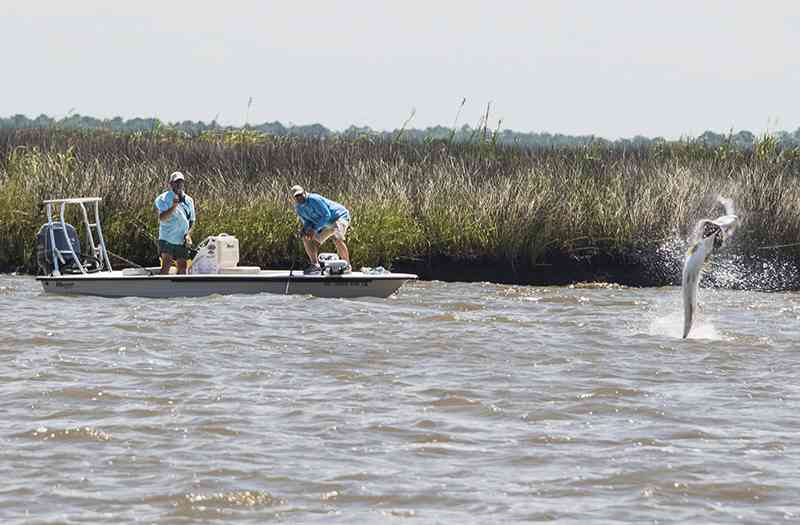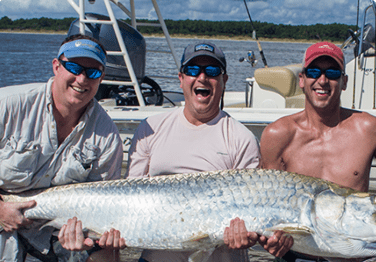If you’re looking to land a big fish, June is a great time to hit the waters for peak Myrtle Beach tarpon fishing. These fish are no joke—they’re huge, they put up a fierce fight, and they can leap like nothing else in the ocean, with muscular builds that fuel their famous high-flying jumps.
It’s this spectacular aerobatic display—often seen as they hurl themselves skyward, shaking in an attempt to throw the hook—that adds an extra layer of adrenaline to the pursuit.

It’s why anglers from everywhere make their way to the Grand Strand this time of year: they’re all after the thrill of battling one of the strongest fish around. Many consider catching a tarpon to be a personal badge of honor—a show of their fishing abilities.
As June arrives, the “silver kings” migrate through these waters in substantial numbers during this time, drawn by the warm currents and abundant food sources. It’s the perfect storm for a tarpon fishing adventure—one that promises not only the thrill of the catch but also the experience of engaging with one of nature’s most impressive marine athletes.
Why Myrtle Beach for Tarpon?
World-Class Fishing Grounds
Just a short drive or boat ride south of Myrtle Beach, areas like Winyah Bay, the Santee Delta, and Cape Romain offer some of the best fishing spots in the region. There’s not much development or boat traffic, which means the waters are calm and the tarpon populations are plentiful.
The tarpon benefit from our mix of open ocean access and sheltered areas like estuaries and rivers, which are rich in baitfish such as menhaden and mullet. These conditions create ideal feeding and breeding grounds for tarpon.
The estuaries south of Myrtle like Winyah Bay and the Santee Delta offer quiet, less disturbed waters where tarpon can frequently be found. These areas are critical not just for mature tarpon but for the younger juveniles, giving them safe havens to grow huge before they move into open waters:

We’re fortunate to have a local ecosystem that supports a healthy tarpon population, which contributes to Myrtle Beach’s reputation as a premier destination for tarpon fishing.
The Fish
Now, about the tarpon themselves—these are some tough fish. Known for their sheer power and the kind of aerial stunts that can make your heart stop, catching one is an unforgettable experience.
Most of these silver kings are big, usually weighing in between 80-120 pounds. But every now and then, you might hook a giant pushing 150 pounds or more. They can grow to about 5 to 8 feet in length, making them one of the largest fish you can catch near coastal areas.

They are remarkably long-lived for fish—and can survive for up to 50 years, which only contributes to their size and the maturity of their fighting capabilities.
As for the spectacular jumping they display, it’s not just a show of strength but also a biological tactic. When tarpon leap, they often shake their heads vigorously, which is believed to be an effort to throw the hook or to gulp air. Unlike most fish, tarpon have a unique swim bladder that functions like a lung, allowing them to breathe atmospheric air and survive in oxygen-poor waters. This ability is why you can find them in different environments around the coast of South Carolina, from open seas to murky inlets.
It’s this combination of great tarpon fishing spots and impressive, hard-fighting fish that makes Myrtle Beach a hotspot for serious fishermen looking to catch monster tarpon.
Where to Go for Tarpon Fishing
Looking for the best spots to fish for tarpon? Head about 20 miles south of Myrtle Beach. That’s where you’ll find prime spots along the coastline, past the breakers, near the jetties and inlets, and even up the rivers.

The tarpon here follow the schools of baitfish like menhaden, so knowing where these baitfish are can lead you right to the tarpon.
Winyah Bay
One of the largest watersheds on the East Coast and a place where fresh and salt water mix, creating an ideal brackish habitat for tarpon. Here, the extensive estuaries and marshlands provide abundant food and shelter for baitfish, which in turn attract the tarpon.
The bay’s wide, open waters are perfect for spotting the silver flashes of tarpon as they chase after schools of menhaden or mullet.
Santee Delta
Further south, the Santee Delta offers another fantastic tarpon fishing spot. This area, where the Santee River flows into the ocean, forms a vast delta with a complex network of channels, inlets, and marshy islands.
The rich nutrients from the river feed the local marine ecosystem, supporting a dense population of baitfish which in turn support a population of large tarpon.
Fishing in the delta can be particularly good near the inlets and smaller creeks during the outgoing tide when tarpon move in to feed.
Cape Romain
Cape Romain is a bit farther down the coast and has a mix of open ocean, tidal creeks, and protected islands. Its remote and relatively undisturbed waters are a haven for wildlife—including tarpon.
The area’s natural jetties and nearby reefs offer structural elements that tarpon use for cover and as hunting grounds. You can often find success here by fishing around the breakers and sandbars where tarpon hunt for baitfish swept out by the currents.
Up the Rivers
Don’t overlook the potential of going upriver. The silver kings travel miles inland following baitfish along rivers like the Pee Dee and Waccamaw. These rivers have slower-moving waters where tarpon can be spotted rolling at the surface as they gulp air.
Note that fishing in these areas requires a quiet approach and a good understanding of river currents and eddies where tarpon may lurk.
Local Knowledge: Fishing Guides & Charters

Now, knowing the area is crucial. The tarpon don’t just hang out on Myrtle Beach—they follow specific migration patterns and move with the tides. Generally, the last two hours of an outgoing tide and the first two hours of the incoming tide are prime times as these are when tarpon are most actively feeding.
Pinpointing which of the many fishing spots will yield tarpon based on the day’s conditions is knowledge that can take years and years to develop. And following the waterways around Myrtle Beach can be tricky due to shifting sandbars, hidden reefs, and strong currents.
This is why a good local tarpon fishing guide comes in handy. These folks already know the waters like the back of their hand. Experienced captains of Myrtle Beach tarpon fishing charters can help you understand when and where the tarpon are likely to be, depending on the time of day and the tide conditions, and have more fun since you can focus on catching the tarpon.

Many people find that once they’ve fished with a skilled guide in Myrtle Beach, they return year after year. That’s because hooking up with a guide isn’t just helpful—it could make the difference between a day of catching nothing, and a day you’ll never forget.
Best Time to Fish for Tarpon
Seasonal Movements
Tarpon begin to appear in Myrtle Beach around late May, but June is a pivotal month where the action really starts to heat up. These fish start to feed aggressively to prepare for the breeding season, making them more likely to strike at bait. This is when the “tarpathon” starts to become significantly more active, making it the perfect time to get out there.
The warmer waters of June also encourage tarpon to move closer to shore where they can be found more frequentlly along the coastline and near the mouths of inlets and rivers.
What You Need to Know Before You Go
Preparation for the Challenge

Before you head out, know that tarpon fishing isn’t a walk in the park. These are tough, strong fish that don’t give up easily.
Expect to battle it out for more than 30 minutes at a time. You’ll need plenty of strength, patience, and stamina. You can try different techniques like drifting with live bait, chucking artificial lures, or even fly fishing to see what works best.
Experience and Equipment
As for experience and gear—while you don’t need to be a pro, some experience definitely helps. And it’s not just about how you handle your rod and reel. Make sure you’re prepared for a real workout and some unpredictable sea conditions.
Having a good set of sea legs helps, especially when fishing in larger bodies of water or under choppy conditions.
Preserving the Species
Tarpon are exclusively catch and release. They definitely aren’t for eating—they’re more about the sport and making sure there are plenty more tarpon for future anglers to enjoy. It’s important to handle them with care and respect, ensuring they go back into the ocean in good shape.
Want to remember your big catch without taking the fish home? You can get a replica made. Myrtle Beach Guide Service works with Gray Taxidermy who can craft a detailed replica of your tarpon. This way, you get a cool memento to hang on the wall, and members of our local fish population get to swim away, no worse for wear. It’s a win-win.
The Bottom Line
Tarpon fishing in hits its peak in Myrtle Beach during the peak of summer, providing not only a sporting challenge but also a display of these massive fish’s impressive leaps and stubborn fights.

Whether you’re aiming to set a new personal best or simply experience the thrill for the first time, the tarpon season in Myrtle Beach is an opportunity you won’t want to miss. Get your timing right, pick the best spots, and gear up properly, and you’re in for one of the best fishing experiences the East Coast has to offer.
Book Tarpon Charters
Whether you’ve been fishing for years or just starting out, hitting the tarpon season in Myrtle Beach is something you definitely don’t want to miss. It’s a chance to test your skills, enjoy some spectacular fights—and maybe even come home with a story or two about the one that didn’t get away…

Ready to head out on the fishing adventure of a lifetime? Myrtle Beach’s waters are calling—and the tarpon are waiting. Whether you’re an experienced angler or just starting out, there’s nothing like the thrill of battling the silver king firsthand.
Captain Jordan Pate and the crew at Myrtle Beach Guide Service are eager to show you the magic of tarpon season and help you land your dream catch. Don’t wait—tarpon are biting, and spots are filling up fast. Join us for an incredible fishing adventure!

